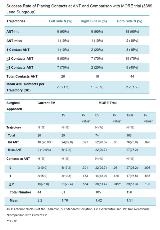A Novel Parietal Approach for Deep Brain Stimulation of the Anterior Nucleus of the Thalamus for Epilepsy
Abstract number :
3.324
Submission category :
9. Surgery / 9A. Adult
Year :
2018
Submission ID :
499462
Source :
www.aesnet.org
Presentation date :
12/3/2018 1:55:12 PM
Published date :
Nov 5, 2018, 18:00 PM
Authors :
Yu-Chi Wang, Chang Gung Memorial Hospital, Chang Gung University; Sanjeet S. Grewal, Mayo Clinic; Erik H. Middlebrooks, Mayo Clinic; Gregory A. Worrell; Matt Stead; Brian N. Lundstrom, Mayo Clinic; Jeffrey W. Britton, Mayo Clinic; Wu Min-Hsien, Chang Gung
Rationale: Deep brain stimulation (DBS) of the anterior nucleus of the thalamus (ANT) is a promising treatment for refractory epilepsy; however, challenges remain with successful targeting of the ANT. The results of Medtronic Registry for Epilepsy (MORE) indicated the superiority of a frontal transventricular(TV) to extraventricular (EV) lead trajectory for ANT DBS. Our objective is to evaluate the safety and targeting efficacy of a novel, posterior EV approach to the ANT and compare with previously reported MORE TV and EV trajectories. Methods: We conducted a retrospective analysis of ten patients having undergone bilateral ANT DBS (20 total trajectories) for medically-refractory epilepsy. Clinical data was assessed for treatment outcomes. Post-operative CT was utilized for electrode localization and co-registered to pre-operative MRI. The DBS Intrinsic Template Atlas (DISTAL) was utilized for ANT localization and contact position relative to ANT was assessed for all trajectories. Results: Our novel trajectory showed a successful ANT hit rate of 90%. Two or more contacts within ANT were present in 75% of patients, significantly greater than the EV trajectory (51.4%, P=.049) and similar with the TV trajectory (72.4%, P=.554) in the MORE trial. Mean contact number in ANT was 2.2, higher than MORE TV(1.76) and EV(1.42) trajectories. There were no intracranial hemorrhages, permanent neurologic deficits, or infections after DBS surgery. Conclusions: The novel parietal trajectory for ANT DBS is a feasible and safe alternative approach to the more frequently utilized TV and EV trajectories used in the MORE trial. Funding: There was no funding received in support of this abstract.

.tmb-.jpg?Culture=en&sfvrsn=7469b05c_0)